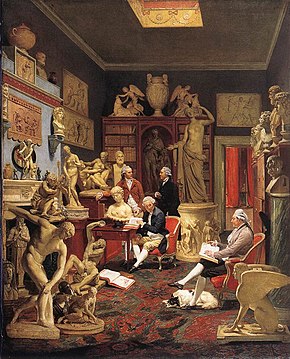Description
The painting witnesses the interest and fascination exercised by the ancient art of Greece and Rome, during the neoclassical period, and the wish to collect ancient pieces, casts or reproductions of Roman or Hellenistic statues experienced by many collectors and intellectuals of that time. In the painting, Charles Townley, the landlord, sits on the right in a red velvet armchair, engaged in a discussion with three friends. The room where the four figures are placed is filled with famous statues and sculptural groups from the ancient times, such as the Discobolus, discovered in 1791 at Hadrian's Villa, and only added to the work (completed in 1782) after that year. [2] In the painting, in fact, Zoffany does not deal so much with describing in detail the interior of the library, of which only the fireplace and the bookcase at the bottom are portrayed, but with creating a picturesque "virtual space" where is gathered the collection of antiquities of Townley, who were actually scattered in several rooms of his home in Park Street, Westminster, in London. [3]
This page is based on this
Wikipedia article Text is available under the
CC BY-SA 4.0 license; additional terms may apply.
Images, videos and audio are available under their respective licenses.
